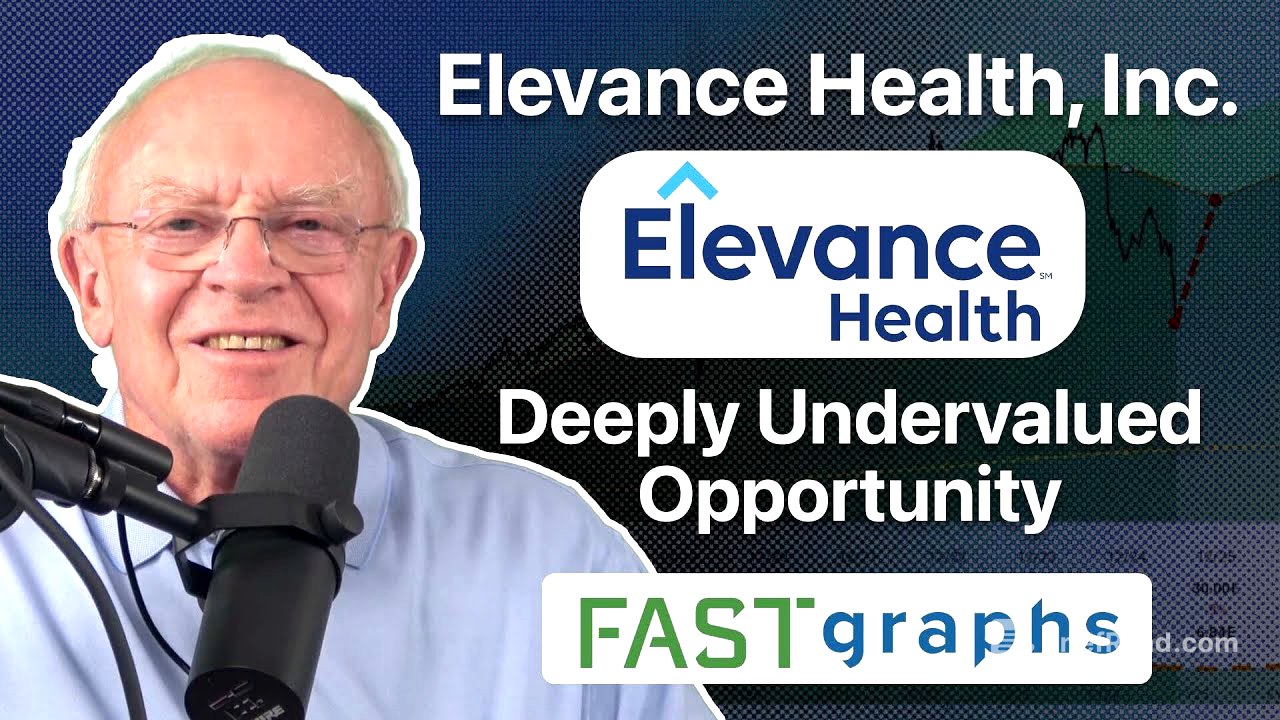TLDR;
Chuck Cardell from FAST Graphs provides an analysis of Elevance Health (ELV), a leading for-profit health insurer. He argues that the stock price has significantly overreacted to recent fundamental challenges, primarily margin pressures in government programs like Medicare and Medicaid. Despite a projected 9% drop in earnings, Elevance remains a strong company with solid cash flows, a growing revenue stream, and strategic initiatives for long-term growth. Cardell suggests the stock is deeply undervalued and presents a compelling long-term investment opportunity.
- Stock price overreaction to short-term volatility.
- Strong cash flows covering the dividend.
- Potential for significant annualized returns.
Introduction: Overview of Elevance Health [0:00]
Chuck Cardell introduces a deep dive into Elevance Health (ELV), emphasizing its attractiveness within the managed healthcare sector. He acknowledges fundamental issues affecting the company, particularly related to Medicare, Medicaid, and the Affordable Care Act. Despite these challenges, Cardell believes the stock price has experienced a dramatic overreaction, driven by short-term market emotions rather than the company's long-term value. He asserts that healthcare is essential and companies like Elevance are here to stay, setting the stage for a comparison of the company's current state versus its position eight months prior.
FAST Graphs Analysis: Understanding Key Metrics [1:35]
Cardell explains the FAST Graphs tool, highlighting that the orange line represents the intrinsic value of Elevance based on its earnings per share, with an 11% historical growth rate and a 15 PE ratio. The gold line indicates dividends per share, which have consistently grown since 2011, supported by a low dividend payout ratio and strong cash flows. Recent margin pressures in government programs have led to a projected 9% drop in earnings for 2025, with management guiding towards $30 per share. He clarifies that he uses adjusted operating earnings for valuation, as it correlates best with the stock price, excluding one-time events and non-cash charges included in diluted earnings.
Stock Price vs. Earnings: Short-Term Volatility and Long-Term Alignment [3:50]
Cardell emphasizes that in the long run, a company's stock price (the black line) tracks its earnings (the orange line), although short-term volatility can lead to periods of overvaluation and undervaluation. He notes that the stock price has fallen about 28% this year, while earnings are expected to drop by only 9%, indicating a significant overreaction. He attributes these short-term fluctuations to market emotions, primarily fear and greed, with fear often being the more powerful driver of overreactions.
Company Overview and Undervaluation Assessment [9:00]
Elevance Health, the second-largest for-profit health insurer in the U.S., serves over 118 million Americans through its key business segments, including Caroline Health Care Services and Wellpoint. Cardell believes the stock is extremely undervalued due to an overreaction to troublesome periods with margin pressures. A discounted cash flow analysis suggests a fair value of around $450 per share, potentially doubling the stock price by the end of the year, representing a 63% undervaluation based on current estimates and guidance.
Cash Flow, Revenue, and Valuation Metrics [10:59]
Elevance has a 2.4% dividend yield and an operating cash flow yield over 9%. Strong cash flows cover the dividend almost three to four times, and the company's free cash flow yield is 8.41%, indicating no immediate risk to the dividend. The most recent earnings report showed a 14% increase in revenues, and the company is trading at a price-to-sales ratio of 0.34, compared to its normal 0.61, further suggesting undervaluation.
Forecasting and Comparison to Previous Analysis [12:39]
Cardell revisits his analysis from eight months prior, noting that earnings expectations for 2025 have decreased from over $34 per share to $30 per share, according to recent management guidance and analyst estimates. Despite these lowered forecasts, $30 would still be the third most profitable number in the company's history. Analysts have also reduced their earnings forecasts for 2026 and 2027. Even with these reduced estimates, the potential annualized rate of return remains attractive, especially if the stock price begins to recover.
Yahoo Finance Article and Fiscal Fitness [15:39]
Cardell mentions an article he posted on Yahoo Finance, detailing the reasons why Elevance should perform well, including its strategic initiatives and industry trends. He reiterates that the current situation is an overreaction to a fundamental issue that is less severe than the market suggests. While operating margins have weakened, net margins, return on assets, return on equity, and return on capital are still reasonably good.
Share Buybacks, Commercial Market, and Long-Term Growth Strategy [17:03]
Elevance has been aggressively buying back its stock since 2005, which Cardell believes will continue. He highlights the commercial market as a bright spot for insurers, where they have more control over payment rates compared to government programs. The company is confident in its long-term growth strategy, initially expecting to deliver at least 12% annual growth, now adjusted to around 9%, which is still attractive.
Investment Recommendation and Company Positioning [19:16]
Cardell recommends taking a position in Elevance, especially for long-term investors, citing its high quality, A-rated status, low long-term debt to capital, and high earnings yield. He believes the stock's undervaluation presents a significant opportunity for it to revert to the mean. Elevance is the second-largest U.S. health insurer, owning about 15% of the market, and is well-positioned with its scale, product diversity, and investments in technology and digital health.
Financial Performance and Strategic Initiatives [20:47]
Elevance reported robust revenue growth in Q1 and Q2 of 2025, but also saw a decline in net income due to rising medical costs, particularly in Affordable Care Act and Medicaid plans. The company's Carolon segment is growing rapidly, supported by acquisitions and product expansion. Elevance is focused on operational efficiency, technological innovation, and value-based care, and is requesting rate increases from regulatory bodies.
Conclusion: Long-Term Opportunity and Market Overreaction [21:53]
Cardell concludes that Elevance presents a solid business with long-term opportunity, despite current political and economic challenges. He believes the market has overreacted to these challenges, creating a long-term opportunity for significant returns. Even with reduced earnings estimates, a 15 multiple by 2027 could yield a 35% annualized rate of return. He encourages viewers to research Elevance on Yahoo Finance and consider the long-term value the company offers.









